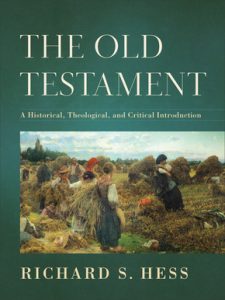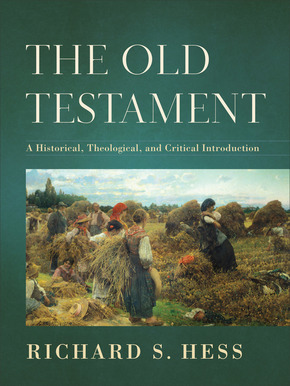Hess, Richard S., The Old Testament: A Historical, Theological, and Critical Introduction. Grand Rapids, MI: Baker Academic, Jan. 2017, pp. 816, $49.99, hardback.
Richard S. Hess (PhD, Hebrew Union College, MDiv and ThM, Trinity Evangelical Divinity School, and a BA from Wheaton College.) is Earl S. Kalland Professor of Old Testament and Semitic Languages at Denver Seminary in Littleton, Colorado, and editor of the Denver Journal. Dr. Hess has authored 9 books, edited or co-edited 33 books, and published more than 100 scholarly articles in collected essays and journals.
The title of the book “The Old Testament: A Historical, Theological and Critical Introduction” is a precise summarization of the contents. In the preface, Hess writes that “This book is designed to meet the needs of the broad variety of students who come to study the Old Testament at a seminary or at a graduate level. It does not presume a deep knowledge of the Scriptures, although I wrote it with the intent to inform any serious reader.” (viii). Hess brings together an articulate synthesis of the Old Testament based on his years of academic research and publications about manuscripts, translations, textual criticism, archaeology, theology and exegesis.
He states in the introduction that there is a threefold purpose: “(1) to explain the definition and structure of the Old Testament, (2) to provide essential guidance regarding the composition and manuscript evidence of the Old Testament, and (3) to orient readers to the study of the Old Testament, surveying the interpretive methods explored in the following chapters of this work.” (p. 1)
The book divides the Old Testament into the standard divisions of: 1) Pentateuch, 2) Historical Books, 3) Poetic Books, and 4) Prophetic Books. Each chapter is devoted to a single Old Testament book (except 1-2 Samuel, 1-2 Kings and 1-2 Chronicles in which each are treated as a single volume). Each discussion of a biblical book is organized into five major components: 1) Name; Text; and Outline, 2) Overview, 3) Reading, 4) Theological Perspectives, and 5) Key Commentaries and Studies.
The first major component is divided into three subheadings. The first subheading (Name) provides an explanation of the origin and meaning of the name of the book. The second subheading (Text) provides a summarization and comparison of manuscripts (e.g. Masoretic, Septuagint, Dead Sea Scrolls, Latin Vulgate). The third subheading (Outline) provides a succinct, concise and descriptive outline of the literary segments of the book.
The second major component (Overview) provides a summarization of the book based on the author’s outline. The overview is primarily an encapsulation of the contents with few interpretive comments. The reader may find minimal help in regards to an explanation of meaning of the text.
The third major component (Reading) has seven subsections: 1) Premodern Readings, 2) Source Criticism, 3) Tradition History, 4) Literary Readings, 5) Gender and Ideological Criticism, 6) Ancient Near Eastern Context, and 7) Canonical Context.
Premodern Readings provides a survey of major expository commentaries from various periods prior to the 20th century. The focus is on primarily Jewish and Christian authors (e.g. Mishnah, Talmud, Patristic, Rabbinic, Reformation).
Source Criticism (labeled Higher Criticism after the Pentateuch) offers and excellent discussion of the major authors and views that have contributed to this field of study, which examines the authorship, sources and development of a book.
Tradition History reviews the theories of oral and/or written compositions that may have contributed to the composition of a book. Other Ancient Near Eastern sources are compared, contrasted and paralleled to biblical passages and cultural practices for insights to the formation and interpretation of the biblical text.
Literary Readings examines the history of approaches that focus on genres, literary features such as repetition of words and phrases, development of literary devices such as plot and characters, as well as interconnection and intertextuality.
Gender and Ideological Criticism, which is a unique contribution, evaluates the portrayal of females and occasionally males, in each book. The criticism provides commentary on the role, characterization and resulting theologies of the portrayal of women. Hess states that his position on gender roles is that of an equalitarian (p. 711).
Ancient Near Eastern Context addresses the historical and cultural milieu of evidence for determining the date, authorship and composition of the book. Archaeological excavations, artifacts and reports are synthesized to help illuminate and/or validate the historical setting of each book. Hess documents many times that some archaeologists claim evidence or conclusions for a biblical context that are based on the absence of evidence in archaeological sites. He incorporates pertinent archaeological discoveries via sidebar sectors that provide significant insights and apologetic comments to the Ancient Near Eastern context. These sidebar sectors are incorporated throughout the book to provide an excellent overview of the contribution of archaeological discoveries. There are over 100 sidebars with commentary, over 50 sidebars with archaeological pictures and images, and a six-page center section of sixteen color pictures of noteworthy sites and artifacts.
The last subsection, Canonical Context, is a blend of Biblical Theology, intertextuality, and citations of the book in the New Testament. This segment provides historical connections throughout the Old Testament and then recognizes the integration of these connections within the New Testament. As with many Old Testament introductions, the theological intertextuality and connections could have been enhanced if the chapters/books were arranged chronologically rather than canonically.
The fourth major component (Theological Perspectives) identifies major biblical and theological themes that are developed throughout the book. These themes provide a foundation for the understanding of the major message or argument of the author(s).
The last major component (Key Commentaries and Studies) offers a list of about six to ten bibliographic references. Hess’ annotated comments are succinct and helpful.
The reader will primarily benefit from Hess’ integration of various disciplines that provide a foundation for the understanding of canonical formation, historical backgrounds and theological development. The reader should not expect extensive exegetical comments or solutions to theological debates.
This book may be of most value to the student/reader who is preparing for a career in academics such as teaching, research and/or writing (MA, ThM, PhD). The sections on Gender and Ideological Criticism provide the student/reader with unique contributions that are not typical in other Old Testament introductions. The student/reader who is preparing for pastoral, counseling, chaplain or other parachurch careers (MACE, MDiv, DMin) would probably benefit more from other introductions that are comprised of more exegetical and theological commentary. This volume may not provide extensive material that would be of substantive engagement in the church pulpit or classroom.
Hess concludes by writing: “This is not an attempt to provide a comprehensive assessment of every view (or even every major view), but it is an argument that an introduction to the Old Testament must embrace an awareness of the many methods that now flourish.” (pp. 712-13).
John A. McLean
Liberty University Rawlings School of Divinity, Lynchburg, VA





